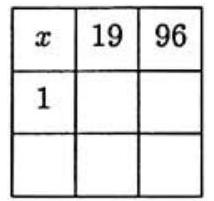¶ 1996 AIME Problems and Solutions
Problem Set Workbook
Access the downloadable workbook for 1996 AIME problems here.
Discussion Forum
Engage in discussion about the 1996 AIME math contest by visiting Random Math AIME 1996 Forum
Individual Problems and Solutions
For problems and detailed solutions to each of the 1996 AIME problems, please refer below:
Problem 1: In a magic square, the sum of the three entries in any row, column, or diagonal is the same value. The figure shows four of the entries of a magic square. Find .

Solution:
Problem 2: For each real number , let denote the greatest integer that does not exceed . For how many positive integers is it true that and that is a positive even integer?
Solution:
Problem 3: Find the smallest positive integer for which the expansion of , after like terms have been collected, has at least terms.
Solution:
Problem 4: A wooden cube, whose edges are one centimeter long, rests on a horizontal surface. Illuminated by a point source of light that is centimeters directly above an upper vertex, the cube casts a shadow on the horizontal surface. The area of the shadow, which does not include the area beneath the cube, is square centimeters. Find the greatest integer that does not exceed .
Solution:
Problem 5: Suppose that the roots of are , and , and that the roots of are , and . Find .
Solution:
Problem 6: In a five-team tournament, each team plays one game with every other team. Each team has a chance of winning any game it plays. (There are no ties.) Let be the probability that the tournament will produce neither an undefeated team nor a winless team, where and are relatively prime positive integers. Find .
Solution:
Problem 7: Two of the squares of a checkerboard are painted yellow, and the rest are painted green. Two color schemes are equivalent if one can be obtained from the other by applying a rotation in the plane of the board. How many inequivalent color schemes are possible?
Solution:
Problem 8: The harmonic mean of two positive numbers is the reciprocal of the arithmetic mean of their reciprocals. For how many ordered pairs of positive integers with is the harmonic mean of and equal to
Solution:
Problem 9: A bored student walks down a hall that contains a row of closed lockers, numbered to . He opens the locker numbered , and then alternates between skipping and opening each closed locker thereafter. When he reaches the end of the hall, the student turns around and starts back. He opens the first closed locker he encounters, and then alternates between skipping and opening each closed locker thereafter. The student continues wandering back and forth in this manner until every locker is open. What is the number of the last locker he opens?
Solution:
Problem 10: Find the smallest positive integer solution to .
Solution:
Problem 11: Let be the product of those roots of that have positive imaginary part, and suppose that , where and . Find .
Solution:
Problem 12: For each permutation of the integers , form the sum
The average value of all such sums can be written in the form , where and are relatively prime positive integers. Find .
Solution:
Problem 13: In triangle , and . There is a point for which bisects and is a right angle. The ratio
can be written in the form , where and are relatively prime positive integers. Find .
Solution:
Problem 14: A rectangular solid is made by gluing together cubes. An internal diagonal of this solid passes through the interiors of how many of the cubes?
Solution:
Problem 15: In parallelogram , let be the intersection of diagonals and . Angles and are each twice as large as angle , and angle is times as large as angle . Find the greatest integer that does not exceed .
Solution:
The problems on this page are the property of the MAA's American Mathematics Competitions